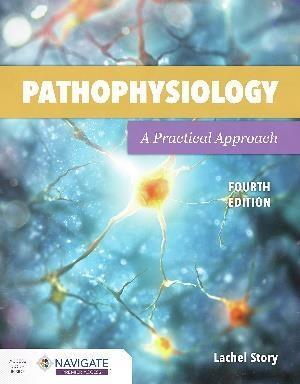Pathophysiology A Practical Approach 4th Edition Full Test Bank

Chapter 1 Cellular Function
1. An increase in cardiac size and function due to increased workload is termed
A) Atrophy.
B) Functional.
C) Hypertrophy.
D) Inflammation.
2. While assessing a patient diagnosed with Marfan's Syndrome, the nurse should include which of the following that is consistent with the syndrome?
A) Cardiac assessment for coarctation of the aorta.
B) Genital assessment for small testicles.
C) Mental assessment for impairment.
D) Oral assessment for cleft palate.
3. Children with PKU must avoid phenylalanine in the diet. Phenylalanine is most likely to be a component of
A) Fat.
B) Sugar.
C) Protein.
D) Carbohydrate.
4. A 17-year-old college-bound student receives a vaccine against an organism that causes meningitis. This is an example of
A) primary prevention.
B) secondary prevention.
C) tertiary prevention.
D) disease treatment.
5. Metaplasia is
A) The disorganization of cells into various sizes, shapes, and arrangements.
B) The replacement of one differentiated cell type with another.
C) The transformation of a cell type to malignancy.
D) An irreversible cellular adaptation.
Download All Chapters Here:
https://nursingrade.com/product/pathophysiology-a-practical-approach-4th-edition-testbank/
6. During a routine ultrasound of a 38 year old women 26 weeks gestation reveals a fetus with a small square head, upward slant of the eyes, and low set ears. The nurse recognizes that these findings are consistent with which of the following?
A) Fragile X Syndrome.
B) Monosomy X (Turner's Syndrome).
C) Trisomy 21 (Down's Syndrome).
D) Trisomy X (Klinefelter's Syndrome).
7. While discussing treatment options with a parent of a newly diagnosed Monosomy X (Turner's Syndrome) child, the nurse should include which of the following?
A) There is no treatment or cure.
B) Symptoms of the condition are treated with estrogen.
C) Symptoms of the condition are treated with testosterone.
D) Institutionalization is the preferred method of managing care.
8. Which of the following assessment findings indicates an alteration in homeostatic control mechanisms?
A) Fever
B) Throat pain
C) Joint stiffness
D) Positive throat culture
9. What information should parents be given about the consequences of phenylketonuria (PKU)?
A) Mental retardation is inevitable.
B) PKU is commonly associated with other congenital anomalies.
C) High dietary tyramine may help induce enzyme production.
D) Failure to treat properly results in progressive mental retardation.
10. Injury that occurs when blood flow is diminished to tissue is called injury.
A) hypoxic
B) ischemic
C) hyperemic
D) neoplastic
11. Tay sachs is caused by which of the following?
A) A deficiency or absence of hexosaminidase A
B) A defect on chromosome 17 or 22
C) A mutation on chromosome 15 Download
An error in converting phenylalanine to tyrosine
12. An obese but otherwise healthy teen goes to a health fair and has her blood pressure checked. This is an example of
A) primary prevention.
B) secondary prevention.
C) tertiary prevention.
D) disease treatment.
13. Characteristics of X-linked recessive disorders include which of the following?
A) The son of a carrier mother has a 25% chance of being affected.
B) Affected fathers transmit the gene to all of their sons.
C) All daughters of affected fathers are carriers.
D) Boys and girls are equally affected.
14. A factor associated with risk of Down syndrome is
A) Maternal age.
B) Maternal alcohol intake.
C) Family history of heritable diseases.
D) Exposure to TORCH syndrome organisms.
15. Which type of gangrene is usually a result of arterial occlusion?
A) Necrosis.
B) Dry.
C) Wet.
D) Gas.
16. The cancer growth continuum is divided into the following stages.
A) Stage 1, Stage 2, Stage 3
B) Initiation, Progression, Promotion
C) Preliminary, Evolutionary, Metastasis
D) Initiation, Promotion, Progression
17. A disease in which the principal manifestation is an abnormal growth of cells leading to formation of tumors is called a disease.
A) congenital
B) degenerative
C) metabolic
Download All Chapters Here:
https://nursingrade.com/product/pathophysiology-a-practical-approach-4th-edition-testbank/
18. The activities of the cell are directed by which cell structure?
A) Cytoplasm
B) Organelles
C) Cell membranes
D) Nucleus
19. Enzymes that use oxidation to convert food materials into energy are found in sausage-shaped structures called
A) endoplasmic reticulum
B) ribosomes
C) mitochondria
D) Golgi apparatus
20. Mitochondria, endoplasmic reticulum, Golgi apparatus, lysosomes, and centrioles are all examples of .
A) cell membranes
B) organelles
C) enzymes
D) None of the above
21. Choose the answer below that best completes the sentence: DNA is composed of base chemicals called .
A) 4; adenine, thymine, guanine, cytosine
B) 3; nucleotide, deoxyribose, base
C) 2: chromosomes, proteins
D) None of the above.
22. Which of the terms below does not describe a method by which cells adapt to changing conditions?
A) Hypertrophy
B) Hyperplasia
C) Increased enzyme synthesis
D) Necrosis
23. Dysplasia of epithelial cells sometimes results from which of the following?
A) Excessive sodium intake
B) Chronic irritation or inflammation
